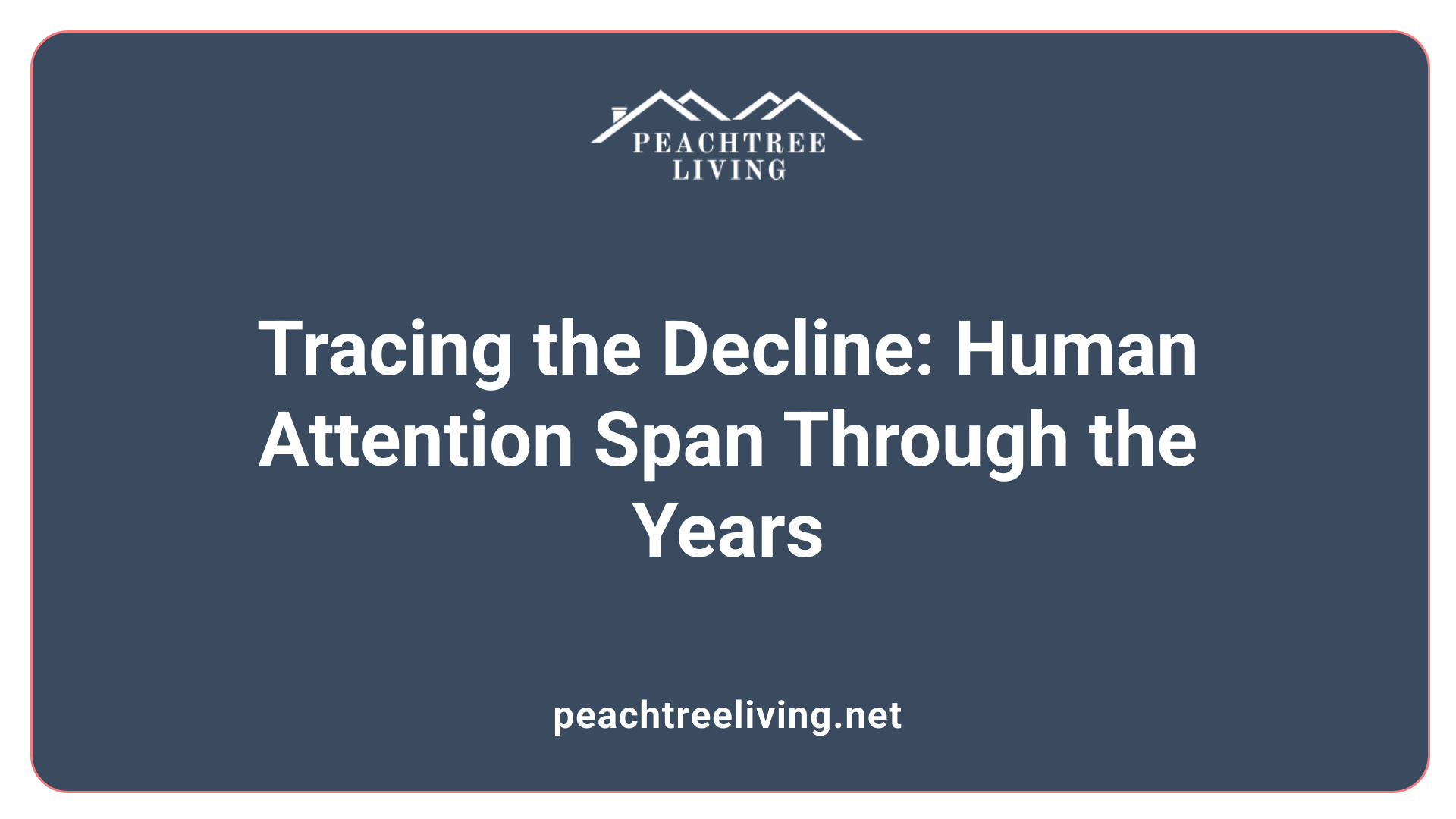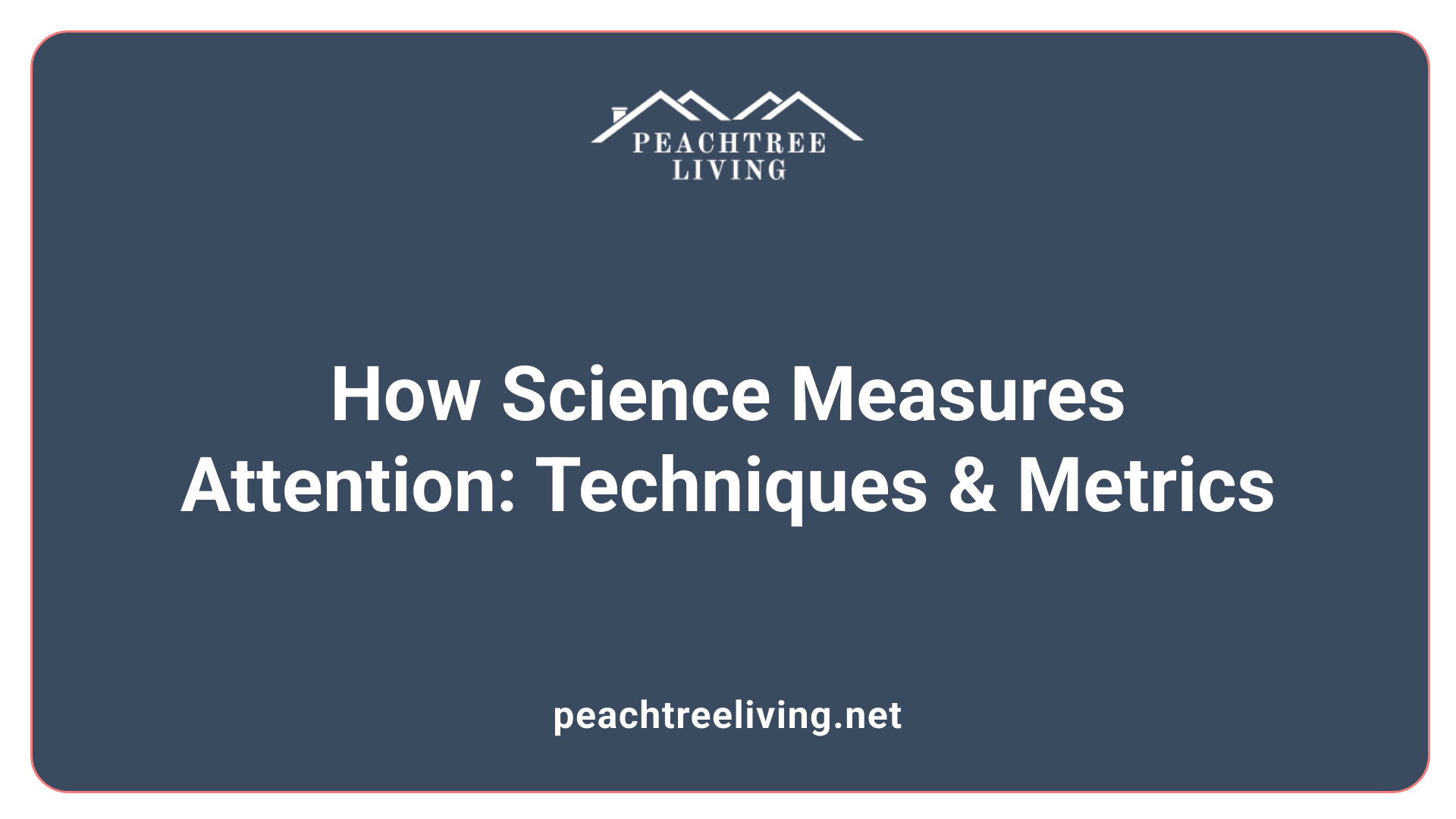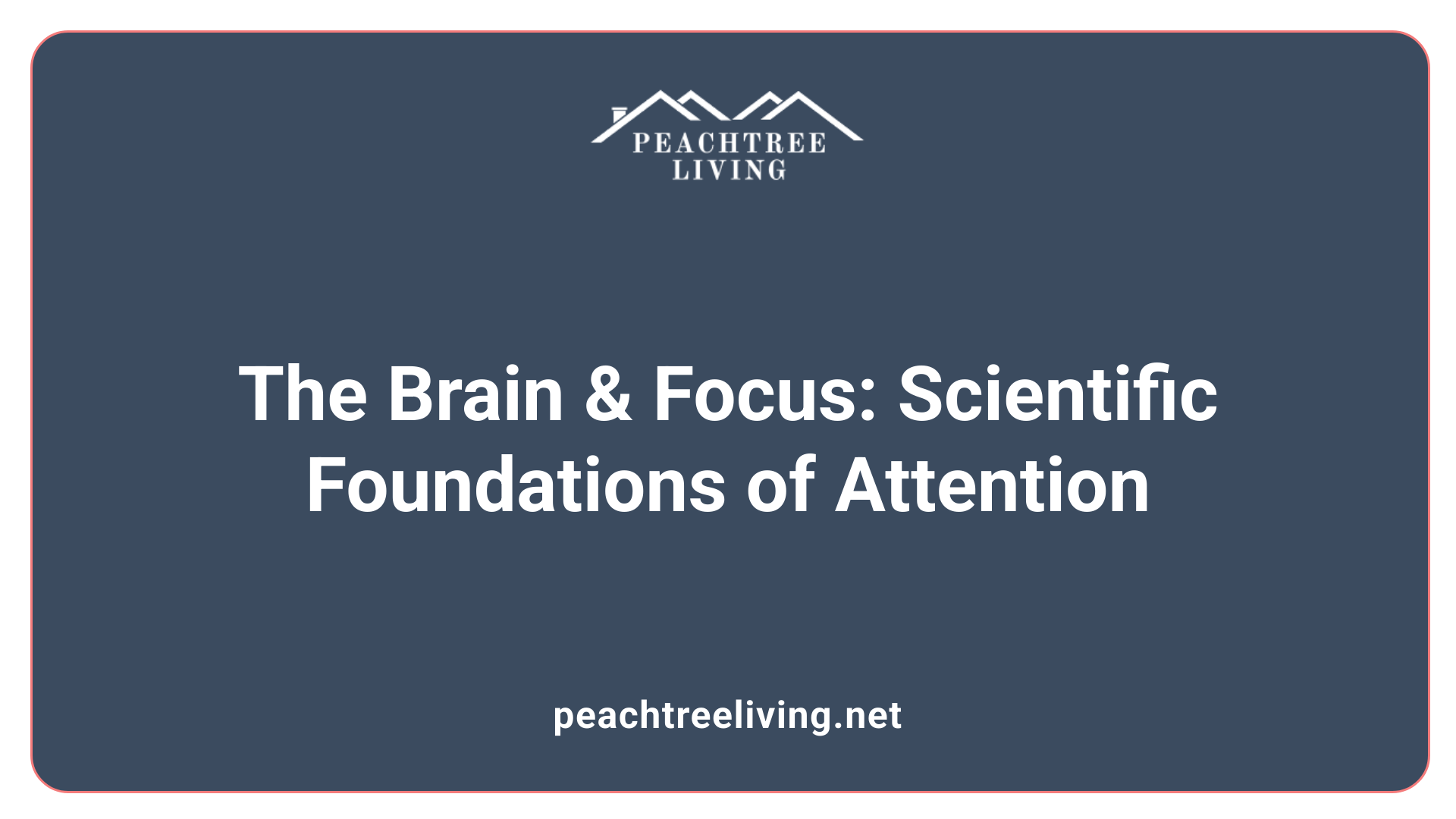Understanding the Evolution of Attention in the Digital Age
In an era dominated by rapid information exchange and technological advancements, the human attention span has become a subject of intense research and societal concern. From the early 2000s to today, studies reveal a notable decline in our capacity to focus, raising questions about the implications for learning, productivity, and mental health. This article explores the latest statistics, scientific insights, and factors influencing attention span to provide a comprehensive understanding of this crucial aspect of human cognition.
Historical Decline of Human Attention Span

How has the human attention span changed over time?
The human attention span has notably decreased over the past two decades, dropping from an average of 12 seconds in 2000 to approximately 8.5 seconds today, representing a decline of about 29%. This rapid reduction is linked closely to the rise of digital technology and the way modern media consumption habits have evolved.
Research shows that in 2004, the average attention span was roughly two and a half minutes. By 2012, this had decreased to about 75 seconds, and in recent years, the average attention span has shrunk further to around 47 seconds, with a median of 40 seconds. Interestingly, scientific comparisons often cite the attention span of a goldfish as 9 seconds, with humans now having a shorter focus duration than this aquatic creature.
This trend toward shorter attention spans is largely driven by the explosion of digital content and mobile devices. Starting around 2000, the proliferation of smartphones, social media, and short-form videos has created a landscape where quick, fragmented bursts of attention have become the norm. Studies indicate that nearly 60% of viewers watch short videos, like those on TikTok or Instagram Reels, for only 41% to 80% of their length, highlighting a preference for brief, engaging content.
The increase in digital notifications, continuous browsing, and multitasking also contribute to mental fatigue, making it harder to sustain focus on longer tasks. Consequently, many people experience higher stress levels, errors, and slower productivity. To combat these effects, experts recommend techniques such as digital detoxing, mindfulness training, and practicing focus on single tasks, aiming to extend attention capacity gradually.
In summary, the decline in human focus over the last two decades is a clear consequence of technological advancements, changing media habits, and constant digital stimulation. Addressing these challenges involves strategies that promote better mental discipline and healthier engagement with technology.
Measuring Attention: Scientific Methods and Metrics

What techniques do scientists use to study attention spans?
Understanding how attention operates in the brain has led researchers to develop various scientific tools and techniques. Among the most common are MRI (Magnetic Resonance Imaging), EEG (electroencephalography), and eye tracking.
MRI scans allow scientists to observe the brain's structure and activity during tasks that require focused attention. These images reveal which areas are activated and how brain networks coordinate to sustain attention.
EEG measures electrical activity, providing real-time data on brain waves associated with different attention states. This technique helps identify moments of heightened focus and lapses.
Eye tracking technology monitors eye movements and fixations, helping researchers understand how attention shifts and how visual engagement correlates with neural activity.
How is attention span measured and why do these metrics matter?
One important metric used by researchers is the A-span (attention span span), which evaluates a person’s capacity to hold and manipulate information in short-term memory. For example, children might have an A-span of about 30 seconds, while young adults average around 76 seconds.
These measures are significant because they quantify cognitive resources available for tasks like learning, problem-solving, and decision-making. A shorter attention span can hamper learning efficiency and increase susceptibility to distractions.
How does attention span vary across age groups and in different scenarios?
Attention span varies considerably depending on age and activity context.
| Age Group | Typical Attention Duration | Context Examples | Notes |
|---|---|---|---|
| Children (0-2 years) | About 2-3 minutes per year | Playing, learning activities | Growing attention capacity with age |
| Teenagers (14-16 years) | 28-48 minutes | School, social interactions | Longer focus during adolescence |
| Young adults (18-35) | Around 76 seconds | Work, study, social media | Attention fluctuates with engagement |
| Older adults (60+) | Approximately 67 seconds | Reading, conversations | Slight decrease compared to young adults |
In addition to age, attention can be influenced by the level of engagement and challenge. Focus peaks during late morning and late afternoon, often aligned with natural alertness rhythms.
These variations have important implications for education, workplace productivity, and mental health. For example, shorter spans in adolescents and adults may reflect effects of digital distraction, while targeted activities and structured breaks can help optimize attention.
Scientific understanding of attention span and its impact on learning
Attention is a limited cognitive resource integral to the processes of learning, memory, and reasoning. Neural networks such as alerting, orienting, and executive control are involved in filtering stimuli, focusing on relevant information, and switching attention.
Current research underscores that the average human attention span has declined sharply over the past twenty years—from around 12 seconds in 2000 to about 8 seconds today. This trend is attributed largely to the proliferation of digital technology and constant notifications that fragment focus.
A reduction in attention span affects learning by decreasing the capacity for deep engagement, leading to more errors, slower performance, and less retention of information. The concept of ‘flow,’ a state of fully immersed focus, is increasingly rare but crucial for effective learning and productivity.
Strategies to combat shrinking attention include managing digital consumption, incorporating regular breaks, and practicing mindfulness. Such approaches help reinforce neural pathways, improve self-control, and sustain attention during demanding tasks.
In summary, attention span is a measurable and malleable cognitive capacity. Scientific techniques help us understand its neural basis and variations, guiding interventions to enhance focus and learning outcomes.
Effects of Digital Technology on Attention Span
How does technology impact human attention spans?
The rise of digital technology, especially smartphones, social media, and online content, has profoundly affected how we focus and process information. Platforms like TikTok, Instagram, and YouTube are designed with features that encourage rapid, continuous engagement, often rewarding quick dopamine hits from instant notifications and short-form videos.
This environment fosters a way of consuming content that emphasizes speed and immediate gratification, making it difficult for users to stay engaged with longer, more complex information. Instead of sustained attention, people frequently switch tasks, responding to alerts and new content almost impulsively. Over the past two decades, measurable declines have been documented in average attention span lengths.
Research indicates that in 2004, people could focus for roughly two and a half minutes. By 2012, this had dropped to about 75 seconds. Currently, attention spans average around 47 seconds, with a median of just 40 seconds. This decline is especially pronounced among children, teenagers, and young adults who spend many hours daily immersed in screens.
This digital bombardment encourages distractibility and impulsivity, making it harder to focus on tasks that require sustained mental effort. Although practices such as mindfulness exercises, setting digital boundaries, and taking regular breaks can help improve focus, the omnipresence and constant nature of online stimuli continue to challenge our ability to concentrate deeply.
In addition to reducing focus duration, digital habits link to increased levels of stress and errors, slower performance, and greater multitasking costs. The ubiquity of technology has created a fast-paced, distraction-rich environment that often undermines our capacity for patience and deep engagement.
| Factor | Effect | Explanation |
|---|---|---|
| Notifications | Frequent interruptions | Promote quick task switching and fragmented focus |
| Short-form content | Reduced attention span | Encourages rapid consumption over deep thinking |
| Digital overload | Increased distractibility | Leads to difficulty in maintaining prolonged focus |
| Instant gratification | Impatience | Fosters a mindset seeking immediate rewards instead of sustained effort |
Strategies such as turning off notifications, practicing mindfulness, and allocating tech-free periods are recommended to combat these effects. However, acknowledging the pervasive role of digital media in daily life is essential for understanding and addressing its influence on our attention and cognitive resilience.
How does technology affect different age groups' attention spans?
Children are particularly vulnerable, often engaging with screens for several hours daily, which raises concerns about their developing attention and self-control. Teenagers tend to have longer attention spans than younger children, yet their focus can be easily disrupted by constant media exposure. Adults experience varied impacts depending on their digital habits, with many reporting increased difficulty maintaining long-term attention and experiencing greater mental fatigue.
While some studies highlight differences in attention span across age groups, the global trend indicates a general decrease concurrent with increased digital media use. Recognizing these patterns helps tailor strategies to improve attention and cognitive health across generations.
Age and Demographic Variations in Attention Span

Are there differences in attention spans across different age groups or demographics?
Yes, attention span varies considerably among different age groups and demographics, influenced by biological, environmental, and lifestyle factors.
Research indicates that young children typically have shorter attention spans, averaging about two to three minutes per year of age. For example, a 14-year-old might focus on an activity for 28 to 42 minutes, while a 4-year-old might only sustain attention for a few minutes.
Teenagers generally demonstrate longer attention spans than younger children, with ranges between 28 and 48 minutes, depending on the task and their engagement level.
Adults display a wide span of focus, but on average, their attention spans are around 76 seconds for younger adults and slightly less, about 67 seconds, for older adults.
Interestingly, research shows that adults’ attention spans are, in some cases, shorter than that of a goldfish, which can focus for approximately 9 seconds. Current data suggest that the adult attention span is roughly 8.25 seconds, reflecting a decline over the past two decades.
This decline correlates strongly with increased exposure to digital technology, such as smartphones, social media, and real-time news, which fragment focus and promote multitasking. For instance, the typical adult checks their phone over 150 times daily and spends more than three hours on it.
Lifestyle factors, including physical activity, stress levels, and media habits, also influence attention. High screen time, especially in childhood, is linked to reduced self-control, attention disorders like ADHD, and symptoms like FOMO.
Studies utilizing MRI scans, eye tracking, and EEG techniques reveal that these environmental influences can alter brain networks responsible for attention, memory, and problem-solving.
Media exposure and lifestyle significantly shape attention spans across age groups, with digital saturation and multitasking contributing to shorter, more fragmented focus.
| Age Group | Typical Attention Span | Comparative Metrics | Notes |
|---|---|---|---|
| Children (0-14) | 2-42 minutes | Varies with age | Increased screen time linked to shorter spans |
| Teenagers | 28-48 minutes | Longer than younger children | Influenced by social media and entertainment |
| Young Adults | About 76 seconds | Shorter than optimal | Digital distractions prevalent |
| Older Adults | About 67 seconds | Slight decline | May compensate with more controlled attention |
| Adults (general) | ~8 seconds | Shorter than goldfish | Notable decline over past two decades |
Impact of Media and Lifestyle
The rise of digital devices and constant notifications have reduced our ability to focus, leading to a perception that attention spans are shrinking.
Children and teenagers, being digital natives, are particularly affected. High daily screen time, sometimes exceeding 7.5 hours for adults and over 3 hours for young children, impacts self-control and focus.
Educationally and professionally, this manifests as difficulties in maintaining attention during lectures, meetings, or long-form reading, where attention tends to drop sharply after just a few seconds.
To mitigate these effects, strategies such as mindful tech use, regular breaks, and engaging in activities that promote active attention—like physical exercise, learning new skills, or meditation—are recommended.
Overall, understanding how demographic factors influence attention is vital to developing better educational approaches, workplace practices, and policies to enhance focus and productivity across all age groups.
Psychology and Science Behind Attention and Focus

What is the scientific understanding of attention span and how it affects learning?
Scientific research portrays attention span as a vital, yet limited, cognitive resource. It functions as a filter, helping us focus on relevant stimuli while ignoring distractions. The brain employs complex neural networks to manage attention, mainly involving alerting, orienting, and executive systems.
Recent studies indicate a significant reduction in attention span over the last 20 years. In 2000, the average attention span was around 12 seconds, but by 2015, it had shrunk to approximately 8.25 seconds. This decline is largely attributed to the rise of digital technology, social media, and constant information bombardment.
The decreased ability to hold focus impacts how effectively individuals learn. When attention is fragmented, deep engagement with content diminishes, leading to poorer retention and understanding. This shrinking attention span hampers sustained concentration necessary for complex problem-solving, critical thinking, and long-term memory formation.
Within the realm of learning, different types of attention are essential:
- Focused attention allows us to block out distractions and concentrate on specific tasks.
- Sustained attention supports extended periods of concentration, vital for studying or deep work.
- Selective attention helps in prioritizing relevant information over irrelevant stimuli.
- Divided attention enables multitasking, though it often reduces overall efficiency.
Disruptions in these attention forms, influenced by environmental factors and psychological states, can lead to increased stress, higher error rates, and slower task completion.
To support better attention, strategies such as managing digital device use, scheduling regular breaks, practicing mindfulness, and engaging in activities that stimulate focus are recommended. Improving attention not only bolsters learning efficiency but also enhances overall cognitive health.
Understanding the neural basis of attention involves insights from advanced techniques like MRI scans, eye-tracking, and electroencephalography. These tools reveal how brain networks related to alertness, focus, and executive function change and adapt over time, especially under the influence of technology-driven distractions.
In conclusion, attention is a crucial component of learning and productivity, intricately linked to brain function and psychological well-being. As digital environments continue to evolve, developing skills to maintain and enhance attention will be vital for educational success and mental health.
Strategies to Improve Attention and Focus
How can individuals improve their attention span?
Research has shown that attention span can be extended through a combination of practical techniques and lifestyle adjustments. One effective strategy is practicing mindfulness meditation, which trains the brain to maintain focus and reduces tendencies for wandering thoughts. Regular mindfulness exercises strengthen attentional control, helping individuals stay engaged with tasks for longer periods.
Reducing digital distractions is also crucial. Turning off notifications on smartphones and computers, setting specific times to check emails and social media, and creating tech-free zones can minimize interruptions. This containment of distractions allows for deeper engagement in activities, whether work, study, or leisure.
Adopting healthy lifestyle habits greatly supports attention. Prioritizing sufficient sleep—since fatigue diminishes focus—is fundamental. Incorporating regular physical activity boosts brain function and concentration. Mental exercises like memory games, puzzles, and sustained reading efforts help train and extend attention span.
Structuring work or study sessions using techniques like the Pomodoro Method—alternating focused work periods with short breaks—helps maintain mental energy and prevents burnout. Also, engaging in activities that promote flow, where one is fully immersed in the activity, can significantly enhance attention and enjoyment.
Creating a mindful, distraction-free environment is essential for cultivating sustained focus. Over time, these combined strategies foster better attention, leading to increased productivity and overall mental well-being.
Myths and Misconceptions About Attention Span

What misconceptions exist regarding attention span statistics?
A common misconception is that the average attention span has shrunk to just 8 seconds, equaling or being shorter than a goldfish's 9 seconds, which misrepresents scientific findings. The often-cited 8-second figure originates from a 2015 Microsoft study, but it oversimplifies and misinterprets data; actual research indicates variability depending on activity and context, with many tasks allowing for longer focused periods.
Attention span is not a fixed number but a fluid measure influenced by factors like environment, task complexity, and individual differences. Misunderstanding these nuances can lead to unnecessary alarm and oversimplification of cognitive capacities.
It’s important to recognize that humans can sustain attention much longer under certain conditions and with proper strategies. Engaging in activities that stimulate focus, like watching movies or participating in stimulating conversations, can extend attention spans.
Many reports and surveys reflect that people believe their attention spans are getting shorter, especially with the rise of digital technology. However, the actual numbers vary, and some research shows that attention may be more about the ability to switch focus quickly rather than a simple decline in sustained attention.
Understanding what attention span truly measures helps to better navigate how technology impacts focus and how to develop practices to improve concentration and mental endurance.
Embracing a Balanced Approach to Attention
While modern technology and busy lifestyles challenge our ability to maintain prolonged focus, understanding the science behind attention and applying practical strategies can help us adapt effectively. Recognizing that attention is a flexible and trainable resource encourages a balanced approach: leveraging digital tools wisely, practicing mindfulness, and maintaining healthy habits. As research continues to unveil the neural mechanisms underlying attention, individuals and societies can foster environments that support mental clarity, learning, and productivity. Embracing this knowledge empowers us to navigate an increasingly distraction-filled world with greater resilience and focus.
References
- Why our attention spans are shrinking, with Gloria Mark, PhD
- 56 Average Human Attention Span Statistics & Facts - Conifer Park
- Are attention spans really collapsing? Data shows UK public are ...
- Squirrel! Why attention spans seem to be shrinking and what we can ...
- The average human attention span, and can substances affect ...
- Average Human Attention Span Statistics & Facts
- The Human Attention Span [INFOGRAPHIC] - Wyzowl
- Quantifying attention span across the lifespan - PMC

